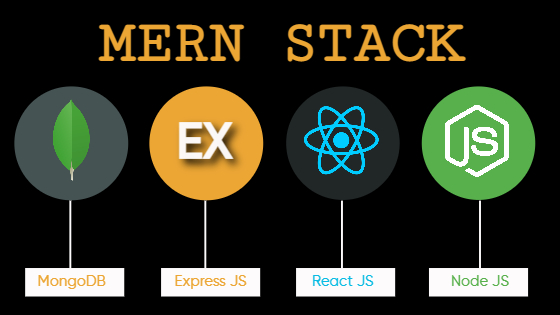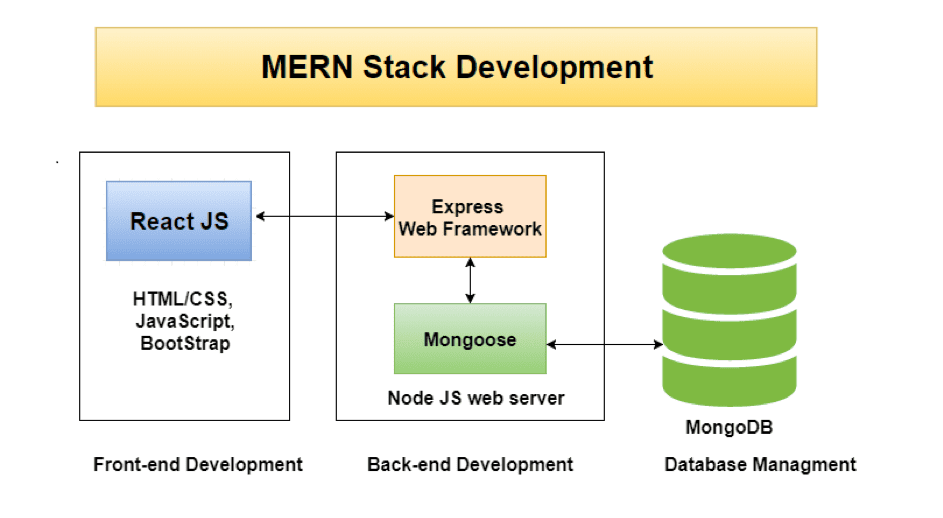In the ever-evolving landscape of web development, the MERN stack has emerged as a powerful and versatile technology stack that empowers developers to create dynamic and interactive web applications.
Consisting of MongoDB, Express.js, React, and Node.js, the MERN stack has gained immense popularity due to its efficiency, flexibility, and ability to build modern web applications.
If you're eager to embark on a journey to become a proficient MERN stack developer, this comprehensive guide will provide you with a step-by-step roadmap to achieve your goal.
What is MERN Stack?

The MERN stack comprises four key technologies that seamlessly integrate to form a complete development environment:
1. MongoDB
MongoDB is a NoSQL database that stores data in a flexible, JSON-like format known as BSON. Its scalability and ability to handle large amounts of unstructured data make it a preferred choice for modern applications.
2. Express.js
Express.js is a back-end framework for Node.js that simplifies the process of building robust and scalable server-side applications. It provides a range of tools and utilities for handling routes, middleware, and more.
3. React
React is a JavaScript library for building user interfaces. Its component-based architecture and virtual DOM enable developers to create reusable and interactive UI components, resulting in a seamless user experience.
4. Node.js
Node.js is a runtime environment that allows developers to execute JavaScript code on the server side. Its non-blocking I/O and event-driven architecture contribute to the creation of high-performance applications.
When combined, these technologies form a cohesive stack that supports end-to-end development, from the back-end server to the front-end user interface.
Prior Skills Need to Learn MERN Stack Development
Before diving into the world of MERN stack development, it's essential to establish a solid foundation in key programming languages and concepts:
1. Essential Programming Languages and Technologies
JavaScript: A deep understanding of JavaScript is vital, as it serves as the backbone of the MERN stack. Familiarize yourself with its syntax, data types, and functions.
HTML and CSS: Proficiency in HTML and CSS is crucial for creating well-structured web pages and styling them effectively.
2. Familiarity with Basic Web Development Concepts
Client-Server Architecture: Understand the fundamental concept of how client-side and server-side components communicate to deliver web content and functionality.
RESTful APIs: Grasp the principles of creating and consuming RESTful APIs, which facilitate data exchange between the front end and back end.
Front-End and Back-End Development: Differentiate between front-end development, which focuses on user interface and interaction, and back-end development, which involves server-side logic and data management.
Process of Learning MERN Stack Development

Embarking on the journey to becoming a proficient MERN stack developer involves a structured learning path. Let's break down the steps:
1. Front-End Development
The front end is what users interact with directly, making it a crucial aspect of web development. Here's how to master it:
a. Mastering HTML and CSS
Start by gaining a strong grasp of HTML for structuring web content and CSS for styling it. This foundation is essential for creating visually appealing and user-friendly interfaces.
b. Fundamentals of JavaScript
Delve into JavaScript's core concepts, including variables, data types, control structures, functions, and objects. This knowledge will serve as the building blocks for more advanced topics.
c. Introduction to React
Learn the basics of React, such as components, JSX syntax, and rendering elements. Create simple applications to understand React's fundamental principles.
d. Advanced React Concepts
Dive deeper into React by exploring state management, hooks, and context API. These features enable the creation of dynamic and interactive user interfaces.
e. Building Interactive UI Components
Apply your React skills to build more complex user interface components, such as forms, modals, and navigation menus. Focus on creating responsive and intuitive designs.
2. Back-End Development
The back end handles data storage, retrieval, and business logic. Here's how to become proficient in back-end development using Node.js and Express.js:
a. Introduction to Node.js and Express.js
Understand the fundamentals of Node.js and Express.js. Set up a basic Express.js server and become comfortable with handling routes and middleware.
b. Setting Up a Server Using Express.js
Create a more comprehensive Express.js server that serves static files, handles HTTP requests, and interfaces with databases.
c. Working with Databases: MongoDB Fundamentals
Explore MongoDB's NoSQL approach, learn about collections and documents, and grasp basic CRUD operations (Create, Read, Update, Delete) in the context of a MongoDB database.
d. Creating RESTful APIs with Express.js
Combine your knowledge of Express.js and MongoDB to build RESTful APIs that enable communication between the front end and back end.
e. User Authentication and Authorization
Implement user authentication and authorization mechanisms using libraries like Passport.js and JSON Web Tokens (JWTs). Secure your applications by managing user sessions and permissions.
3. Full-Stack Integration
Now it's time to bring together your front-end and back-end skills to create a full-fledged MERN application:
a. Connecting React with Express.js
Learn how to establish communication between your React front end and Express.js back end. This involves making API requests from the front end to retrieve and update data on the server.
b. Fetching and Displaying Data from the Server
Practice fetching data from your Express.js API and displaying it on the React front end. Understand asynchronous operations and ensure a smooth user experience.
c. Handling HTTP Requests and Responses
Master the process of sending HTTP requests from the front end and receiving and handling those requests on the server side. Implement error handling and validation for a robust application.
d. Building a Complete MERN Application
Bring everything together by building a comprehensive MERN application. This could be a simple to-do list, a blogging platform, or an e-commerce website.
4. Advanced Topics
To grow your skills as a MERN stack developer, delve into advanced concepts that enhance your application's functionality and performance:
a. State Management with Redux
Explore Redux, a state management library for React. Learn how to manage global application state efficiently, leading to better organization and improved performance.
b. Real-Time Applications Using WebSockets
Implement real-time features using WebSockets. Create chat applications and live data updates that enhance user engagement and interaction.
c. Server-Side Rendering (SSR) with Next.js
Discover Next.js, a framework that enables server-side rendering for React applications. Learn the benefits of SSR in terms of SEO, performance, and user experience.
d. Deployment and Hosting Strategies
Understand various deployment options for your MERN applications. Learn how to host your application on platforms like Heroku, Netlify, and AWS, ensuring it's accessible to users.
Working on Real World Projects

A significant aspect of becoming a skilled MERN stack developer is practical application. Here, we'll outline a few hands-on projects that align with your skill development journey:
1. To-Do List Application
Create a basic to-do list application that allows users to add, edit, and delete tasks. Focus on implementing CRUD operations, user authentication, and dynamic UI updates.
2. Blogging Platform with User Authentication
Build a blogging platform where users can write, edit, and publish blog posts. Implement user authentication to ensure only authorized users can create and manage their content.
3. E-Commerce Platform with Cart Functionality
Develop an e-commerce website with product listings and shopping cart functionality. Implement features like product search, filters, and a user-friendly checkout process.
For each project, follow these steps:
a. Planning and Design
Outline the project's scope, features, and user flows. Create wireframes and mockups to visualize the user interface.
b. Implementation of Features
Build the project incrementally, starting with core functionalities and gradually adding advanced features. Test each feature thoroughly before moving on.
c. Troubleshooting and Debugging
Expect to encounter challenges along the way. Develop strong debugging skills to identify and resolve issues efficiently.
Collaborate And Make Connections With Others In The Same Field

As you advance in your MERN stack journey, collaboration and networking can accelerate your learning and career growth:
1. Joining Developer Communities and Forums
Participate in online communities and forums to connect with fellow developers, ask questions, and share your knowledge.
2. Participating in Open-Source Projects
Contribute to open-source projects related to the MERN stack. This provides hands-on experience, exposure to real-world codebases, and collaboration with experienced developers.
3. Attending Webinars, Meetups, and Conferences
Stay updated on the latest trends and advancements by attending webinars, meetups, and conferences focused on web development and the MERN stack.
4. Connecting with Fellow Learners and Professionals
Connect with fellow learners and professionals on platforms like LinkedIn and Twitter. Networking can lead to job opportunities, mentorship, and valuable insights.
Continuous Learning and Keeping Up

The world of web development is dynamic and constantly evolving. To remain relevant, embrace continuous learning:
1. Rapid Evolution of Web Technologies
Stay informed about updates and new features in the MERN stack technologies. Follow official blogs, newsletters, and social media accounts of relevant technology communities.
2. Incorporating New Technologies
Explore new technologies and tools that complement the MERN stack. For example, learn about GraphQL as an alternative to RESTful APIs or dive into Docker for containerization.
Building a Portfolio
A strong portfolio showcases your skills and projects to potential employers or clients:
1. Compiling and Showcasing Projects
Feature your completed projects in your portfolio. Include a variety of projects that highlight different aspects of your skills, from front-end design to back-end functionality.
2. Creating a Personal Website or GitHub Repository
Build a personal website to display your portfolio and share your journey as a developer. Alternatively, maintain a well-organized GitHub repository with detailed project descriptions and code.
3. Demonstrating Your Skills
Explain your thought process, design decisions, and challenges faced during project development. Demonstrate your ability to create clean, maintainable code.
Job Opportunities and Career Path

Upon honing your skills, various job opportunities and career paths await you in the world of MERN stack development:
1. Various Roles and Job Titles for MERN Stack Developers
Explore roles like front-end developer, back-end developer, full-stack developer, and MERN stack developer. These roles may vary based on the focus of responsibilities.
2. How to Prepare for Job Interviews
Brush up on your technical skills and be prepared to discuss your projects and problem-solving approach during job interviews. Highlight your ability to work with the MERN stack effectively.
3. Freelancing vs. Full-Time Employment
Consider whether you want to work as a freelancer or seek full-time employment. Freelancing offers flexibility, while full-time employment provides stability and potential career growth.
3-Month MERN Stack Development Course
A 3-month MERN stack development course is an intensive program designed to provide you with a solid foundation in MERN technologies within a relatively short span. Here's what you can expect:
Accelerated Learning: These courses are structured to cover the essential concepts swiftly, focusing on hands-on practice and projects.
Time Commitment: With a shorter duration, a 3-month course requires a more concentrated effort. It's ideal for those who want to upskill quickly.
Entry-Level Proficiency: After completing a 3-month course, you'll likely have a foundational understanding of MERN technologies, enabling you to build basic web applications.
Ideal for Beginners: If you're new to web development or have limited time, a 3-month course can be an excellent starting point.
6-Month MERN Stack Development Course

A 6-month MERN stack development course offers a more comprehensive learning experience, allowing for deeper exploration of concepts and projects:
Thorough Understanding: With an extended duration, you'll have more time to delve into each component of the MERN stack, gaining a deeper understanding.
Project Complexity: Longer courses often involve more intricate projects, enabling you to build complex applications and explore advanced features.
Time for Iteration: A 6-month course provides room for revisiting concepts, practicing extensively, and refining your skills through continuous projects.
Career-Ready Skills: Completing a 6-month course can equip you with a higher level of proficiency, making you more competitive in the job market.
Suitable for Career Changers: If you're transitioning to web development or want to switch careers, a 6-month course offers a comprehensive transition period.
Choosing the Right Course Duration

The choice between a 3-month and a 6-month MERN stack development course depends on your goals, prior experience, and time availability. Here are some factors to consider:
Time Commitment: Assess how much time you can dedicate to learning. If you're juggling work, studies, or other commitments, a 6-month course might provide a balanced learning pace.
Learning Style: Consider your preferred learning pace. Are you comfortable with an intensive learning schedule, or do you prefer a more gradual approach?
Previous Experience: If you have prior coding experience or familiarity with some web technologies, a 3-month course might be sufficient to enhance your skills.
Depth of Understanding: If you aim to thoroughly understand MERN stack concepts and build complex applications, a 6-month course could be the better option.
Career Goals: Your career aspirations play a role. If you're aiming for junior or mid-level developer positions, a 6-month course might offer a more competitive edge.
Conclusion
Embarking on the journey to become a proficient MERN stack developer is both challenging and rewarding. With a structured learning path, hands-on projects, and continuous learning, you can master the essential technologies and skills required for modern web development.
The MERN stack's versatility and power will enable you to create dynamic and interactive web applications that meet the demands of today's digital landscape. So, take the first step, embrace the learning process, and unlock the limitless possibilities that await you in the world of MERN stack development.



